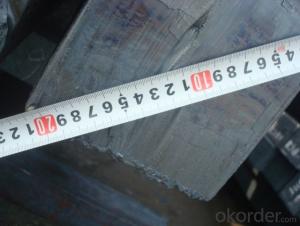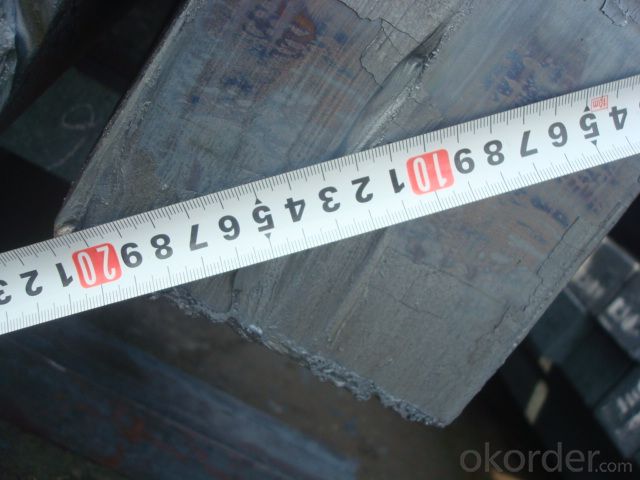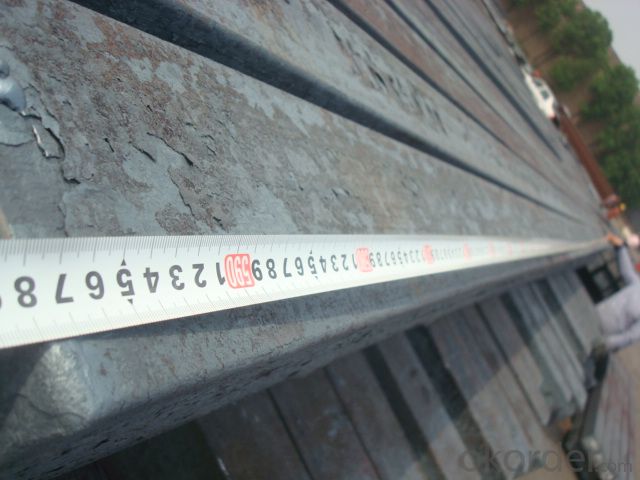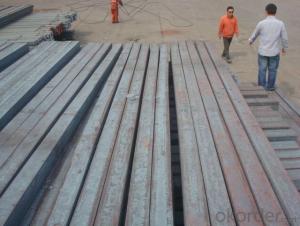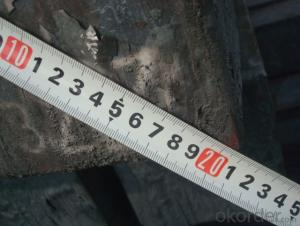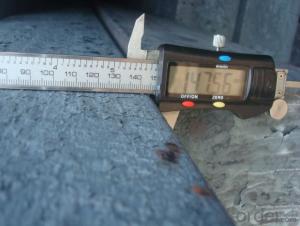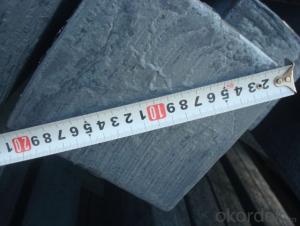Steel Bloom Manufactured by Big Blast Furnace
- Loading Port:
- Tianjin
- Payment Terms:
- TT OR LC
- Min Order Qty:
- 1000 m.t.
- Supply Capability:
- 100000 m.t./month
OKorder Service Pledge
OKorder Financial Service
You Might Also Like
Steel Bloom Manufactured by Big Blast Furnace
1.Structure of Steel Bloom Manufactured by Big Blast Furnace
Steel Bloom Manufactured by Big Blast Furnace is the raw material of all kinds of steel mill. Billet section of square, round, flat, rectangular and abnormity, etc Several, mainly related to shape of rolled products. Simple rolled section steel, choose cross section of square billet or rectangular billet. rolling The sector products such as flat steel, Angle steel, select the rectangular billet or slab. Had better profiled billet when production beams, channels, and in rolling process Lines and improve the yield. The raw material of round billet is the production of seamless tube.
2.Main Features of Steel Bloom Manufactured by Big Blast Furnace
Steel Bloom Manufactured by Big Blast Furnace section size should meet the requirements of rolling deformation and finished product quality, but also roll strength and biting condition of restrictions. General steel Billet section height H. And the roll diameter D The ratio of the ( namely H/D) Should be less than or equal to zero 0.5 . Length of steel billet by finishing temperature, Rolling time and the length of the product Or times ruler. When heated too long accident prone to bump the furnace wall of steel, too short, furnace bottom utilization rate is not high, influence the heating furnace production. For the production Choose a variety of steel and steel billet, should consider the affinities of billet, as far as possible in order to improve the productivity of the roughing mill, simplify the stock management of workshop.
3. Steel Bloom Manufactured by Big Blast Furnace Images
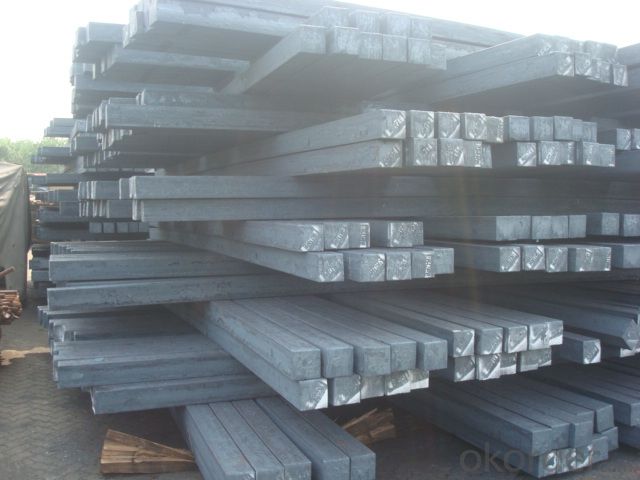
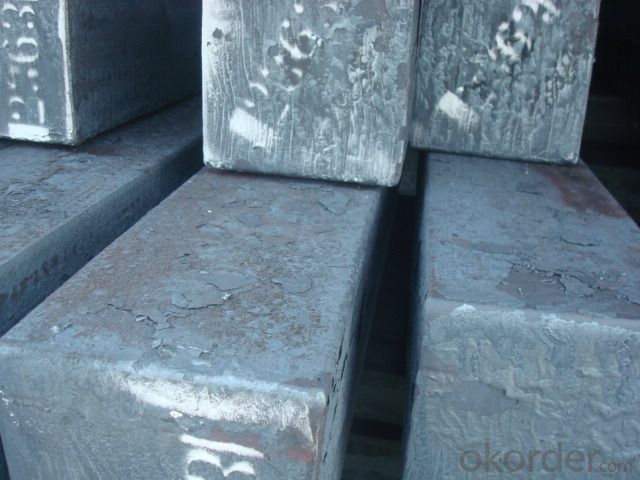
4. Steel Bloom Manufactured by Big Blast FurnaceSpecification
Steel Billet Manufactured by Blast Furnace rolled steel, after processing can be used for mechanical parts, forging parts, processing all kinds of steel, steel Q345B channel steel, wire rod is the role of the billet. Steel billet is used in the production of semi-finished products, generally cannot be used directly for the society. Steel billets and steel are strictly divided into standard, cannot decide to whether the business enterprise of the final product, and according to unified standards to perform the whole society. Typically, billet and the steel is relatively easy to distinguish, but for some steel billet, and have the same specification and same steel purposes (such as rolling tube billet), whether can be used for other industries, whether through steel processing process, whether through a finished product rolling mill processing to distinguish
Material standard The editor Range of thickness: 150-240 - mm + / - 5 mm width range: 880-1530 - mm + / - 20 mm Length: 3700-10000 - mm + / - 500 - mm Cross-sectional size: 64 * 64; 82 * 82; 98 * 98; 124 * 124; 120 * 150; 152 * 164; 152 * 170 mm Length: 9000 mm Section of tolerance: billet: 1.0 + / - 2.0-1.0 + / - 1.0 mm slab: width: + / - 2.0 mm thickness: + / - 3.0 mm The length tolerance: + / - 200 mm Section diagonal tolerance: 3.5-8.0 MM Billet section size protrusions requirements: < 1242 mm, do not allow; > = 1242 mm, < = 2 mm 1242 mm, < = 3 mm Beheading (shear) extension deformation: < 1242 mm billet: no control; The slab: < = 15 mm Surface tilt: no more than billet section 0.1 Bending: every 1 m length is not more than 10 mm The distortion: length < = 5 m, < = 11. ; The length of the < = 7.5 M, < = 5. Material % 3 sp/PS chemical composition: C Mn Si S P
5.FAQ of Steel Bloom Manufactured by Big Blast Furnace
①How about your company?
A world class manufacturer & supplier of castings forging in carbon steel and alloy steel,is one of the large-scale professional investment casting production bases in China,consisting of both casting foundry forging and machining factory. Annually more than 8000 tons Precision casting and forging parts are exported to markets in Europe,America and Japan. OEM casting and forging service available according to customer’s requirements.
②What is the advantage of the continue Casting steel Bloom comparing to the die casting steel Bloom?
Compared with die casting, continuous casting has the advantages of: 1. To simplify the Steel Bloom The production process 2. Improve the metal yield 3. Improve the quality of the Bloom 4. Reduces the steel worker's labor intensity 5. Save energy and reduce consumption
Steel Bloom is produced by the method of through three processes: It is through the steelmaking system of continuous casting equipment, directly by the molten steel pouring into Bloom; The second is the steelmaking system in the production of steel ingot casting Bloom through system of steel rolling rolling equipment or processing of steel semi-finished products; Three is the steelmaking system production of steel ingot by forging the semi-finished product processing equipment.
③How about the Q235 Grades?
Q235:A、B、C、D(GB700-88)
Q235A:C0.14~0.22% Mn0.30~0.65Si≤0.30S≤0.050P≤0.045
Q235B:C0.12~0.20% Mn0.30~0.670Si≤0.30S≤0.045P≤0.045
Q235C:C≤0.18% Mn0.35~0.80Si≤0.30S≤0.040P≤0.040
Q235D:C≤0.17% Mn0.35~0.80Si≤0.35S≤0.040P≤0.035
- Q: What are the different methods of steel billet cooling?
- The steel industry commonly employs various methods for cooling steel billets. These methods encompass air cooling, water cooling, and controlled cooling processes. Air cooling serves as one technique to cool steel billets. It entails allowing the billets to cool naturally in the surrounding air, without any additional cooling mechanisms. This method is straightforward and cost-effective, although it may result in slower cooling rates and less control over the cooling conditions compared to other methods. Water cooling represents another prevalent method for cooling steel billets. It involves immersing the billets in water or showering them with water to expedite the cooling process. Water cooling provides more efficient and controlled cooling rates compared to air cooling. It facilitates faster cooling and aids in achieving desired material properties, such as heightened hardness or improved microstructure. Controlled cooling processes constitute a more advanced approach to cooling steel billets. These processes involve meticulous control over temperature and cooling rates to attain specific material properties. One such process, known as quenching, encompasses rapidly cooling the billets in a controlled medium, such as oil or water, to achieve the desired hardness. Another controlled cooling process is referred to as annealing, which involves gradually cooling the billets to relieve internal stresses and enhance their machinability. Furthermore, specialized cooling techniques, such as spray cooling and water mist cooling, find application in specific industries or situations. These methods entail spraying a fine mist of water onto the billets to achieve rapid and uniform cooling. Overall, the selection of a cooling method hinges on several factors, including desired material properties, production requirements, and cost considerations. Different cooling methods offer distinct advantages and compromises, necessitating steel manufacturers to choose the most suitable approach for their specific needs.
- Q: What are the common sizes and shapes of steel billets?
- Steel billets come in various sizes and shapes depending on their intended use. Common sizes for steel billets range from 100mm to 300mm in diameter and 3 meters to 12 meters in length. Shapes can vary from round or square to rectangular, octagonal, or even irregular shapes, depending on the requirements of the specific industry or application.
- Q: What is the drop per minute of the billet temperature at 850?
- Cold rolling is not considered. The initial rolling temperature (surface) of the billet is generally 1000-1150 degrees.
- Q: How are steel billets used in the production of fasteners?
- Steel billets are an essential raw material in the production of fasteners. Fasteners, such as bolts, screws, and nuts, are commonly made from steel due to its strength, durability, and corrosion resistance. Steel billets are the first step in the manufacturing process of fasteners. The production of fasteners begins with the creation of steel billets, which are semi-finished products made through a process called casting. During casting, molten steel is poured into molds to form solid billets with a specific shape and size. These billets are then allowed to cool and solidify. Once the steel billets are formed, they undergo further processing to transform them into fasteners. The billets are heated to a specific temperature, which allows them to be easily shaped and formed. They are then sent through a series of machines, such as rolling mills, to reduce their cross-sectional area and shape them into the desired form, such as rods or wires. After the initial shaping, the steel billets are further processed to create the specific fastener type. For example, if bolts are being produced, the billets are typically rolled into long rods, which are then cut into appropriate lengths. These lengths are then threaded using specialized machines to create the screw-like structure of bolts. Similarly, for screws and nuts, the billets are shaped into wires and then cut into appropriate lengths. The wires are then further processed to create the required thread pattern. This can be done through processes like thread rolling or thread cutting. Overall, steel billets play a crucial role in the production of fasteners. They serve as the starting material from which fasteners are formed, and their properties, such as strength and durability, contribute to the quality and reliability of the final product. The ability to shape and transform steel billets allows manufacturers to create a wide range of fasteners that meet various industrial and consumer needs.
- Q: What are the different welding techniques used for steel billets?
- There are several different welding techniques that can be used for steel billets, depending on the specific requirements and desired outcome of the project. Some of the most commonly used techniques include: 1. Shielded Metal Arc Welding (SMAW): Also known as stick welding, SMAW is a versatile and widely used welding technique. It involves using a consumable electrode coated in flux, which provides a shielding gas to protect the weld pool from atmospheric contamination. SMAW can be used for both thick and thin steel billets and is suitable for various applications. 2. Gas Metal Arc Welding (GMAW): GMAW, also known as MIG (Metal Inert Gas) welding, is a popular technique for welding steel billets. It uses a continuous wire electrode and a shielding gas to protect the weld pool. GMAW is known for its high productivity and is often used for welding thin to medium steel billets. 3. Flux-Cored Arc Welding (FCAW): FCAW is similar to GMAW but uses a tubular electrode filled with flux instead of a solid wire. The flux provides a shielding gas and can also contain additional alloying elements. FCAW is commonly used for welding thick steel billets and in outdoor or windy environments where shielding gas could be easily blown away. 4. Gas Tungsten Arc Welding (GTAW): GTAW, also known as TIG (Tungsten Inert Gas) welding, is a precise and versatile technique frequently used for high-quality welds on steel billets. It utilizes a non-consumable tungsten electrode and a separate filler material if needed. GTAW produces clean and precise welds but is slower compared to other techniques. 5. Submerged Arc Welding (SAW): SAW is a welding process that involves the formation of an arc between a continuously fed wire electrode and the steel billet. The arc is shielded by a granular flux, which also provides additional alloying elements and protects the weld pool. SAW is commonly utilized for welding thick steel billets, such as in the manufacturing of large structures or pipes. Each of these welding techniques has its advantages and disadvantages, and the choice of technique depends on factors such as the type and thickness of the steel billet, desired weld quality, productivity, and environmental conditions. It is crucial to select the appropriate welding technique and ensure proper training and safety precautions are followed to achieve successful and durable welds on steel billets.
- Q: How are steel billets used in the manufacturing of medical devices?
- Steel billets are used in the manufacturing of medical devices in various ways. Firstly, steel billets serve as a raw material for the production of surgical instruments, such as scalpels, forceps, and scissors. These devices require a high level of strength, durability, and corrosion resistance, which steel billets can provide. Additionally, steel billets are used in the manufacturing of implants, such as joint replacements and dental implants. These devices need to be able to withstand the load and stress exerted by the human body, and steel billets are an ideal material due to their excellent mechanical properties. Moreover, steel billets are used in the production of medical equipment, such as hospital beds, wheelchairs, and surgical tables. These devices require a sturdy and robust structure, and steel billets can provide the necessary strength and stability. Furthermore, steel billets are also utilized in the manufacturing of medical equipment components, such as brackets, frames, and supports. These components play a crucial role in the functioning and stability of medical devices, and steel billets are often chosen due to their high machinability and weldability. Overall, steel billets are an essential raw material in the manufacturing of various medical devices. Their strength, durability, corrosion resistance, and other mechanical properties make them a suitable choice for producing surgical instruments, implants, medical equipment, and their components.
- Q: What is the role of steel billets in the construction of dams and reservoirs?
- Steel billets play a crucial role in the construction of dams and reservoirs. These billets, which are semi-finished steel products, serve as the primary raw material for manufacturing various components and structures needed in the construction process. One of the main applications of steel billets in dam and reservoir construction is for the production of reinforced concrete. Reinforced concrete is a composite material that combines the strength and durability of steel with the moldability and versatility of concrete. Steel billets are used to produce steel reinforcement bars, commonly known as rebars, which are embedded within the concrete to enhance its tensile strength and prevent cracking under heavy loads. These rebars provide structural support to the dam or reservoir, ensuring its stability and longevity. Additionally, steel billets are utilized in the fabrication of gates, penstocks, and other mechanical components required in dams and reservoirs. These components are crucial for regulating the flow of water, controlling the water level, and managing the release of water from the reservoir. Steel billets are forged, rolled, or machined to create these specialized components, ensuring their strength, reliability, and resistance to corrosion. Furthermore, steel billets are used in the construction of spillways, which are designed to safely discharge excess water from reservoirs during periods of heavy rainfall or flood. The spillway gates, channels, and other structures are often made from steel billets, as they need to withstand high water pressure and turbulent flow conditions. In summary, steel billets are indispensable in the construction of dams and reservoirs. They are used to produce reinforced concrete, providing structural support and increasing the overall strength of the structure. Steel billets are also employed in the manufacturing of gates, penstocks, spillways, and other mechanical components, guaranteeing the efficient operation and long-term durability of these essential water management infrastructure.
- Q: How are steel billets used in the manufacturing of food processing equipment?
- Steel billets are indispensable for the production of food processing equipment. These semi-finished steel products serve as the raw material for making various components and parts needed in the construction of food processing machinery. First and foremost, steel billets are utilized to construct the main structural frame of the equipment. The strength and durability of steel make it perfect for providing the necessary stability and support for the entire machinery. By cutting and shaping the billets to the desired dimensions, a solid framework is formed, ensuring that it can endure the demanding requirements of industrial food processing. Additionally, steel billets are also employed in the manufacturing of specific components within the equipment. For example, they are used to create cutting blades, grinding discs, and mixing paddles, which are vital in the food processing process. These components must be sturdy and resistant to wear and corrosion, and steel billets offer the ideal material to meet these requirements. Moreover, steel billets are often chosen for constructing food processing equipment that requires high levels of hygiene and cleanliness. Particularly, stainless steel billets are favored in such applications due to their inherent resistance to rust and corrosion. These billets are used to fabricate parts that come into direct contact with food, such as storage tanks, conveyors, and mixing chambers, ensuring that the food processing equipment is safe and hygienic. Furthermore, steel billets are employed in the manufacturing of heat exchangers and boilers used in food processing. These billets are designed to withstand high temperatures and pressure, making them suitable for applications that involve cooking, sterilization, or pasteurization of food products. To conclude, steel billets play a critical role in the production of food processing equipment. From providing structural support to fabricating specific components, they contribute to the creation of robust, efficient, and hygienic machinery that is essential for the food industry.
- Q: What are the different types of surface defects found in steel billets?
- There are several types of surface defects that can be found in steel billets, including cracks, scabs, laps, seams, and surface pinholes.
- Q: What are the future trends in steel billet production?
- Some of the future trends in steel billet production include advancements in automation and robotics, increased use of renewable energy sources in the production process, implementation of more efficient and sustainable production techniques, and the development of new alloys and materials to enhance the performance and strength of steel billets. Additionally, there is a growing focus on reducing carbon emissions and improving the overall sustainability of steel production, leading to the exploration of greener technologies and practices in the industry.
Send your message to us
Steel Bloom Manufactured by Big Blast Furnace
- Loading Port:
- Tianjin
- Payment Terms:
- TT OR LC
- Min Order Qty:
- 1000 m.t.
- Supply Capability:
- 100000 m.t./month
OKorder Service Pledge
OKorder Financial Service
Similar products
Hot products
Hot Searches
Related keywords
